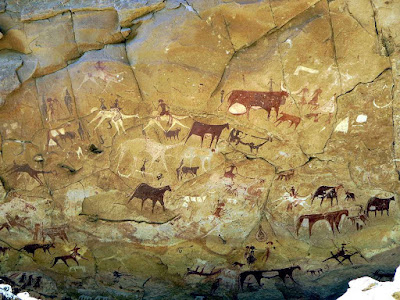Saturday, May 9, 2020
CATTLE IN AFRICAN ROCK ART:
Cattle. Photograph TARA
(Trust for African Rock Art)
Pretty
much anywhere you find rock art one of its most important themes is going to be
involved with primary sources of food for the indigenous population. This is
why there are so many horses and reindeer illustrated in the painted caves of
Europe, and so many bison in the rock art of North America. In Africa, the San
people (so-called Bushmen) illustrated their most sought after game animals,
especially eland but also giraffes and others. However, in the tribal cultures
of Africa the predominate animal in their rock art has been cattle images.
"Crying cows" of Algeria.
Photographs TARA.
"Archaeological
and genetic evidence suggests that domestication of cattle occurred 10,000 BP
in Western Asia. After this migrations of humans and cattle about 8,000 years
BP occurred followed by interbreeding with wild cattle in Northern Africa to
produce breeds local to the continent. More than 60% of the rock art of the
Sahara depicts cattle or cattle related activities reflecting the importance of
these events. All around Africa however, cattle depictions in rock art
abound." (TARA 2016:1)
African cow petroglyph.
Photograph after Noguera.
Red painted African cattle with herders.
Internet photograph - public domain.
I
assume that originally these people lived a classical pastoral lifestyle,
relying on their herds for food and resources. In a recent paper published in
the Proceedings of the National Academy
of Sciences a team consisting of Katherine M. Grillo, assistant professor
of anthropology at University of Florida, Fiona Marshall of Washington
University, and Julie Dunne (who led the study) at the University of Bristol
looked for traces of milk consumption on ancient pottery to confirm that the
cultures relied on this food resource. "After
excavating pottery at sites throughout east Africa, team members analyzed
organic lipid residues left in the pottery and were able to see evidence of
milk, meat and plant processing. 'This is the first direct evidence we've ever
had for milk or plant processing by ancient pastoralist societies in eastern
Africa,' Grillo said. 'The milk traces in ancient posts confirms the story that
bones have been telling us about how pastoralists lived in eastern Africa 5,000
to 3,000 years ago - an area still famous for cattle herding and the historic
way of life of people such as Maasai and Turkana,' Marshall said."
(Heritage Daily 2020)
African cattle petroglyphs.
Internet photographs - public domain.
But
the role of cattle in these societies goes way beyond the role of mere
foodstuffs. Perhaps inevitably, the herds became not only signs of wealth but
acquired spiritual value because of that importance. "Today many people see cows (and the consumption thereof) either
as a contributor to environmental destruction, or as a solution to feeding the
world's population. Both views are centered on the (important) role that cows
play in providing food primarily in the form of milk and meat. But cattle are
more than that. Through millennia and in different places in Africa, cattle
have been imbued with significant symbolic and social meanings in addition to
their role as food providers." (TARA 2016)
Red painted African cattle with herders.
Internet photograph - public domain.
This
importance of cattle led to their portrayal in many cases as discrete
individuals instead of generic cattle. "Cattle
were perceived as having unique horns, especially among longhorn cattle which
occupied a large population. For instance, some cattle were given lyre-shaped
horns. Cattle were known to have a large financial, cultural, and environmental
impact on the people of the Ennedi highlands. They were also given distinct
coats to individualize these animals, and rock art at some sites including the
Chiguéou II site, includes cattle figures in extravagant geometric designs.
Cattle were found all among the highlands, while other animals, such as horses,
were not." (Stanley 2015)
Painted cow, Wadi el Firaq,
Internet photograph - public domain.
Therefore, African rock art portraying cattle must be viewed as a much
more complex phenomenon than just groceries or even wealth. They are viewed as
beautiful, objects of devotion and desire as well as a means of sustenance. "So there are many reasons why cattle
were, and still are, prized and cared for in many
African societies: beauty, hardiness, religio-spiritual use, social and
political value - and food." (TARA 2016)
In other
words, African cattle images can carry meanings and have implications pointing
to virtually all aspects of a culture and its value systems.
NOTE:
Some images in this posting were retrieved from the internet with a search for
public domain photographs. If any of these images are not intended to be public
domain, I apologize, and will happily provide the picture credits if the owner
will contact me with them. For further information on these reports you should
read the original reports at the sites listed below.
REFERENCES:
Heritage
Daily,
2020 Milk
Pioneers: East African Herders Consumed Milk 5,000 Years Ago,
https://www.heritagedaily.com/2020/04/milk-pioneers-east-african-herders-consumed-milk-5000-years-ago/127612
Noguera,
Alessandro Menardi
2016 The
Chiguéou II Rock Art Site Revisited (Ennedi, Chad), February 8, 2016,
https://independent.academia.edu/AlessandroMenardiNoguera
Stanley,
David
2015 Prehistoric
Rock Paintings at Manda Guéli Cave in the Ennedi Mountains - Northern Chad,
https://commons.wikimedia.org/w/index.php?curid=51016097
TARA
(Trust for African Rock Art),
2016 Cattle in
African Rock Art and Traditions, January 22, 2016,
https://africanrockart.org/news/cattle-in-african-rock-art/
Subscribe to:
Post Comments (Atom)













No comments:
Post a Comment